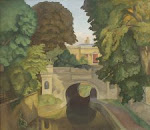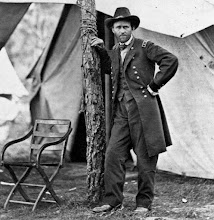"Fair after foul weather" -- the subject of my previous post -- got me to thinking about one of my favorite poems by Edward Thomas. Thomas started writing poetry in December of 1914, and he wrote the following poem during that month.
When Thomas was debating with himself whether to begin writing poetry, Robert Frost suggested to him that he should, as a start, turn some of his descriptive prose passages into verse. "Interval" is not, unlike some of Thomas's poems, traceable to a specific passage in his prose writings. However, one can see that he took Frost's advice to heart: the first six stanzas are wholly descriptive. Of course, to call them merely "descriptive" is to sell them short: very few poets (or writers in general) are capable of writing with such deceptively simple depth.
Then, in the final two stanzas, the touch that makes Thomas who he is (and, I believe, a great poet) comes to the fore: the sudden turn into a wider realm that is intensely personal and, at the same time, common to us all. Very few poets are capable of carrying this off on a consistent basis. Thomas is one of those who does so, again and again.
Robin Tanner, "Martin's Hovel" (1927)
Interval
Gone the wild day:
A wilder night
Coming makes way
For brief twilight.
Where the firm soaked road
Mounts and is lost
In the high beech-wood
It shines almost.
The beeches keep
A stormy rest,
Breathing deep
Of wind from the west.
The wood is black,
With a misty steam.
Above, the cloud pack
Breaks for one gleam.
But the woodman's cot
By the ivied trees
Awakens not
To light or breeze.
It smokes aloft
Unwavering:
It hunches soft
Under storm's wing.
It has no care
For gleam or gloom:
It stays there
While I shall roam,
Die, and forget
The hill of trees,
The gleam, the wet,
This roaring peace.
Edna Longley (editor), Edward Thomas: The Annotated Collected Poems (Bloodaxe Books 2008).
Note how each of the first six stanzas is a single sentence. Each stanza is similar in spirit and in imagery (although not in form) to a haiku. (I am not suggesting that Thomas modeled the stanzas on the haiku form. This is simply how they strike me.) The final two stanzas -- which make the turn into the wider realm -- consist of a single sentence that runs across the stanzas.
As is often the case in Thomas's poetry (and prose), death makes an appearance. But, please note: Thomas is not morbidly obsessed with mortality. Honesty was always his instinctive governing principle. If death makes an appearance -- or love or beauty -- so be it. Whatever is in one of his poems is there because it is true to what Thomas thought and felt. Remember: "True and not feigning."
Paul Drury, "March Morning" (1933)
Thursday, May 24, 2012
Subscribe to:
Post Comments (Atom)





8 comments:
Ah, finally someone I know a little about! Edward Thomas - the man - the poet - saw the world through a sharp clear eye. He once said he wished he could give that clarity of vision to his wife Helen (who saw the world through different eyes, as did friend Eleanor Farjeon). He really did SEE the tiniest details and jotted down little scraps of description which grew into verse when he finally DID begin to gravitate towards poetry.
One image here - and I don't doubt it is the beech hangers above Steep, the village near Petersfield where he spent several years whilst his children attended Bedales school - but such clarity. His boyhood apprenticeship with the writings of naturalist Richard Jefferies served him well.
Your perceptive understanding of this poem gives me a more holistic understanding of it now. Thank you.
Stephen,
I at first thought the two paintings were by the same person. They both have that gnomish look about them, if than makes any sense. They appear to be illustrations one might find in a book of fairy tales.
Bovey Belle: thank you very much for visiting again, and for your thoughts on ET. Yes, I think that the beech hangers near Steep appear in a few of his poems. Another example is "The Path", which begins: "Running along a bank, a parapet/That saves from the precipitous wood below/The level road, there is a path."
I agree that he did not miss anything. Reading his prose confirms this. And many of these close observations worked their way into his poems, as you know.
Thanks again.
Fred: the similarity in styles of Tanner and Drury is probably attributable to the fact that they were both influenced by Samuel Palmer, whose work has appeared here a number of times. I'm sure that, in particular, you noticed the light effects, which are very reminiscent of a number of Palmer's engravings.
As ever, thanks for dropping by, and for your comment.
Stephen,
Yes, both are rather dark for the most part except for that one burst of light on or behind the dwelling place. The light seems strangely constrained or perhaps contained.
I am delighted to stumble across your blog - particularly as I have just finished reading 'Now all roads lead to France' the excellent biography of the last years of Edward Thomas and the Dymock group of poets that formed just before the war. Thank you for this illuminating post.
Fred: you see that element quite a bit in Tanner's work in particular. He was also fond of using the moon in that fashion. Thanks for the thoughts.
alice c: thank you very much for your kind words. I haven't had a chance to read that book yet, but I intend to.
I'm pleased that you found your way here.
Thanks again.
Post a Comment